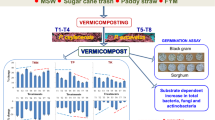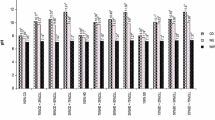Abstract
Purpose
Homestead farming systems generate in addition to the economic produce, huge quantities of diverse agro-wastes, which are resources containing significant levels of plant nutrients and organic carbon. This biomass resource is either grossly underutilized or completely unutilized, posing disposal or environmental problems. To utilize these organic wastes effectively, a study was undertaken on bioconversion of residue biomass with different characteristics to value added vermicompost for use in crop production.
Methods
Physico-chemical characteristics of residue biomass were determined. Vermicomposting experiment was carried out with residue biomass from 14 crops/trees taken individually and cow dung in the ratio of 10:1 using an indigenous epigeic earthworm belonging to Eudrilus species. Quality and maturity parameters of vermicompost obtained were assessed.
Results
The bioconversion efficiency and the earthworm multiplication varied significantly among the residue biomass of different crops/trees. The biomass materials from banana, arecanut palm, coconut palm, rubber, teak, and cassava plants as well as weeds were vermicomposted with a conversion efficiency of > 60%. During the vermi-stabilization process, carbon loss was < 20% from the residues of rubber and mango and > 50% from residues of teak, banana, wild jack fruit tree, coconut palm and cocoa. Bioconversion resulted in an increase in pH, electrical conductivity and major plant nutrients (N, P) while C:N and C:P ratios decreased in all crop residues. Significant relationship between major plant nutrients in crop residues with maturity parameters of vermicompost was demonstrated.
Conclusion
Vermi-stabilization holds promise as a biological tool for management of residues of crops/trees in homestead farming system. However, certain residues were not efficiently converted to vermicompost and might require pretreatments or mixing of residues to achieve higher efficiency of bioconversion.
Similar content being viewed by others
References
Matson, P.A., Parton, W.J., Power, A.G., Swift, M.J.: Agricultural intensification and ecosystem properties. Science. 277(5325), 504–509 (1997)
Smil, V.: Crop residues: agriculture’s largest harvest. BioSci. 49, 299–308 (1999)
Sidhu, A.S., Sekhon, N.K., Thind, S.S., Hira, G.S.: Residue management for sustainable crop production in summer moong–maize–wheat sequence. J. Sust. Agric. 22(2), 43–54 (2003)
Adi, A.J., Noor, Z.M.: Waste recycling: utilization of coffee grounds and kitchen waste in vermicomposting. Bioresour. Technol. 100, 1027–1030 (2009)
Alvarenga, P., Clarisse, M., Farto, M., Palma, P., Sengo, J., Morais, M.-C., Cunha-Queda, C.: Quality assessment of a battery of organic wastes and composts using maturity, stability and enzymatic parameters. Waste Biomass Valoriz. 7, 455–465 (2016)
Harris, G.D., Platt, W.L., Price, B.C.: Vermicomposting in a rural community. BioCycle. 31(1), 48–51 (1990)
Logsdon, G.: Worldwide progress in vermicomposting. BioCycle. 35(10), 63–65 (1994)
Prabhu, S.R., Subramanian, P., Biddappa, C.C., Bopaiah, B.M.: Prospects of improving coconut productivity through vermiculture technologies. Indian Coconut J. 29, 79–84 (1998)
Gopal, M., Gupta, A., Thomas, G.V.: Opportunity to sustain coconut ecosystem service through recycling of the palms leaf litter as vermicompost: Indian Scenario. Coconut Res. Dev. (CORD). 26(2), 42–55 (2010)
Thomas, G.V., Palaniswami, C., Gopal, M., Gupta, A.: Recycling coconut leaf-agro wastes mixture using Eudrilus sp. and growth promotion properties of coconut leaf vermicompost. Int. J. Innov. Hort. 1(2), 113–118 (2012)
Chatterjee, R., Bandyopadhyay, S., Jana, J.C.: Evaluation of vegetable wastes recycled for vermicomposting and its response on yield and quality of carrot (Daucus carota L.)., Int. J. Recycl. Org. Waste Agric. (2014). https://doi.org/10.1007/s40093-014-0060-4
Fernandes, E.C.M., Nair, P.K.R.: An evaluation of the structure and function of tropical home gardens. Agric. Syst. 21, 279–310 (1986)
Jacob, J., Joy, M.: Integrated approach towards coconut-based farming systems. In: Thampan, P. K., Vasu, K. I. (eds.) Coconut for rural welfare, pp. 109–116. Asian and Pacific Coconut Community, Jakarta (2007)
Swaminathan, M.S.: The promise of agro-forestry for ecological and nutritional security. In: Steppler, H. A., Nair, P. K. R. (eds.) Agroforestry: a decade of development, pp. 25–41. International Centre for Research on Agroforestry (ICRAF), Nairobi (1987)
Peter, K.V., Prasada Rao, G.S.L.V.: Homestead farming in the warm humid. Kerala Calling 2005, 30–35 (2005)
Walkley, A., Black, I.A.: An examination of Degtjareff method for determining soil organic matter and a proposed modification of the chromic acid titration method. Soil Sci. 37, 29–37 (1934)
Kjeldahl, J.: A new method for the estimation of nitrogen in organic compounds. Z Anal. Chem. 22, 366 (1883)
Bray, R.H., Kurtz, L.T.: Determination of total, organic and available forms of phosphorus in soils. Soil Sci. 59, 39–45 (1945)
Hanway, J.J., Heidel, H.: Soil analysis method as used in Iowa state college soil testing laboratory. Iowa State Coll. Agric. 57, 1–31 (1952)
Zucconi, F., Pera, A., Forte, M., de Bertoldi, M.: Evaluating toxicity of immature compost. BioCycle. 22, 54–57 (1981)
Suthar, S.: Nutrient changes and biodynamics of epigeic earthworm during recycling of some agricultural wastes. Bioresour. Technol. 98, 1608–1614 (2007)
Haimi, J., Huhta, V.: Comparison of composts produced from identical wastes by vermistabilization and conventional composting. Pedobiology. 30(2), 137–144 (1987)
Fares, F., Albalkhi, A., Dec, J., Bruns, M.A., Bollag, J.M.: Physicochemical characteristics of animal and municipal wastes decomposed in arid soils. J. Environ. Qual. 34(4), 1392–1403 (2005)
Sharma, S.: Municipal solid waste management through vermicomposting employing exotic and local species of earthworms. Bioresour. Technol. 90(2), 169–173 (2003)
Jadia, C.D., Fulekar, M.H.: Vermicomposting of vegetable waste: a bio-physicochemical process based on hydro-operating bioreactor. Afr. J. Biotechnol. 7(20), 3723–3730 (2008)
Raghavendra, M.A., Bano, K.: Studies on the manorial value of vermicompost from different green leaves. Curr. Res. 30(3/4), 35–37 (2001)
Kale, R.D.: Earthworms: nature’s gift for utilization of organic waste. In: Edwards, C.A. (ed.) Earthworm ecology. CRC Press, Boca Raton (1998)
Dominguez, J.: State-of-the-art and new perspectives on vermicomposting research. In: Edwards, C.A. (ed.) Earthworm ecology, 2nd ed., pp. 401–424. CRC Press, Boca Raton (2004)
Bernal, M.P., Alburquerque, J.A., Moral, R.: Composting of animal manures and chemical criteria for compost maturity assessment—a review. Bioresour. Technol. 100, 5444–5453 (2009)
Bansal, S., Kapoor, K.K.: Vermicomposting of crop residues and cattle dung with Eisenia foetida. Bioresour. Technol. 73(2), 95–98 (2000)
Chauhan, A., Joshi, P.C.: Composting of some dangerous and toxic weeds using Eisenia fetida. J. Am. Sci. 6, 1–6 (2010)
Tognetti, C., Mazzarino, M.J., Laos, F.: Composting biosolids and municipal organic waste: effects of process management on stabilization and quality. Biol. Fertil. Soils. 43, 387–397 (2007)
Ghosh, G.N., Chattopadhyay, K., Bara, l.: Transformation of phosphorus during vermicomposting. Bioresour. Technol. 69, 149–154 (2007)
Manyuchi, M.M., Phiri, A., Muredzi, P., Chitambwe, T.: Comparison of vermicompost and vermiwash bio-fertilizers from vermicomposting waste corn pulp. Int. J. Biol. Biomol. Agric. Food Biotechnol. Eng. 7(6), 389–392 (2013)
Blouin, M., Hodson, M.E., Delgado, E.A., Baker, G., Brussaard, L., Butt, K.R., Dai, J., Dendooven, L., Peres, G., Tondoh, J.E., Cluzeau, D., Brun, J.J.: A review of earthworm impact on soil function and ecosystem services. Eur. J. Soil Sci. 64, 161–182 (2013)
Jouquet, E.P., Bloquel, E., Thu, D.T., Ricoy, M., Orange, D., Rumpel, C., Tran, D.T.: Do compost and vermicompost improve macronutrient retention and plant growth in degraded tropical soils? Compost. Sci. Util. 19, 15–24 (2011)
Degefe, G., Mengistou, S., Mohammed, S.: Physico chemical evaluation of coffee husk, wastes of enset (Enset ventricosum), vegetable and khat (Catha edulis) through vermicomposting employing an epigeic earthworm Dendrobaena veneta (Rosa, 1886). Afr. J. Biotechnol. 15(20), 884–890 (2016)
Suthar, S., Singh, S.: Vermicomposting of domestic waste by using two epigeic earthworms (Perionyx excavatus and Perionyx sansibaricus. Int. J. Environ. Sci. Technol. 5(1), 99–106 (2008)
Ananthakrishnasamy, S., Gunasekaran, S., Manimegala, G.: Fly ash-lignite waste management through vermicomposting by indigenous earthworms Lampito mauritii. Am. Eurasian J. Agric. Environ. Sci. 5, 720–724 (2009)
Song, X., Liu, M., Wu, D., Griffiths, B.S., Jiao, J., Li, H., Hu, F.: Interaction matters: synergy between vermicompost and PGPR agents improves soil quality, crop quality and crop yield in the field. Appl. Soil. Ecol. 89, 25–34 (2015)
Edward, C.A.: The use of earthworms in the breakdown and management of organic wastes. In: Edward, C.A. (ed.) Earthworm ecology, pp. 327–354. CRC Press, Boca Raton (1998)
CCQC: Compost maturity index. California Compost Quality Council, Nevada City (2001)
Morais, F.M.C., Queda, C.A.C.: Study of storage influence on evaluation of stability and maturity properties of MSW compost. In Advances for a sustainable Society Part II: proceedings of the fourth international conference of ORBIT association on biological processing of organics, Perth, Australia, 2003
Hand, P., Hayes, W.A., Frankland, J.C., Satchell, J.E.: The vermicomposting of cow slurry. Pedobiology. 3, 199–209 (1988)
Yan, C.H., Ahmed, O.H., Kassim, S., Majid, N.M.A.: Co-composting of pineapple leaves and chicken manure slurry. Int. J. Recycl. Org. Waste Agric. 2, 23–31 (2013)
Arancon, N., Pant, A., Radovich, T.J.K., Potter, J.K. and. Converse, C.E.: Seed germination and seedling growth of tomato and lettuce as affected by vermicompost water extracts (teas). HortScience. 47(12), 1722–1728 (2012)
Edwards, C.A., Arancon, N.Q., Greytak, S.: Effects of vermicompost teas on plant growth and disease. Biocycle. 47, 28–31 (2006)
Gopal, M., Gupta, A., Sunil, E., Thomas, G.V.: Amplification of plant beneficial microbial communities during conversion of coconut leaf substrate to vermicompost by Eudrilus sp. Curr. Microbiol. 59, 15–20 (2009)
Savy, D., Cozzolino, V., Vinci, G., Nebbioso, A., Piccolo, A.: Water-soluble lignins from different bioenergy crops stimulate the early development of maize (Zea mays L.). Molecules. 20, 19958–19970 (2015)
Savy, D., Cozzolino, V., Antonio, N., Drosos, M., Nuzzo, A., Mazzei, P., Piccolo, A.: Humic-like bioactivity on emergence and early growth of maize (Zea mays L.) of water-soluble lignins isolated from biomass for energy. Plant Soil. 402, 221–233 (2016)
Acknowledgements
The authors thank Kerala State Council for Science, Technology and Environment, Government of Kerala for funding the Emeritus Scientist Scheme on “Bioconversion of residues from major crops of Kerala and food processing to value added organic resource for sustainable farming” in which this work was carried out. We are grateful to the Director, Council for Food Research and Development, Konni, Kerala for providing facilities to carry out this work. We also thank Mr. C. H. Amarnath, Formerly Technical Officer, ICAR-CPCRI Kasaragod for statistical analysis of the data.
Author information
Authors and Affiliations
Corresponding author
Ethics declarations
Conflict of interest
The authors declare no conflict of interest.
Rights and permissions
About this article
Cite this article
Thomas, G.V., Mathew, A.E., Baby, G. et al. Bioconversion of Residue Biomass from a Tropical Homestead Agro-Ecosystem to Value Added Vermicompost by Eudrilus Species of Earthworm. Waste Biomass Valor 10, 1821–1831 (2019). https://doi.org/10.1007/s12649-018-0203-3
Received:
Accepted:
Published:
Issue Date:
DOI: https://doi.org/10.1007/s12649-018-0203-3




